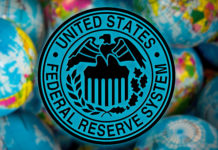The S&P500 hit a record high yesterday, its 30th record high since the beginning of this year. The technology stocks led the rally. Apple, which revealed its plans to integrate ChatGPT into its iPhones last week, gained 2% and Tesla jumped more than 5% on news that it has been given approval to test its advanced driver-assistance system on some streets in Shanghai. Nasdaq 100 is now a few points below the 20’000 psychological mark and it’s not about if but when it will take out this level. Nasdaq’s PE forward ratio is around 26, high but still lower than the 2020 peak, and much lower than the dot.com levels. IMF said that almost a third of global capital flew int the US since Covid, compared to only 18% before the pandemic. The slow recovery and political turmoil in Europe, war in Ukraine and the geopolitical tensions with China help driving funds toward fertile American markets thanks to new AI opportunities – and high interest rates. Bloomberg points that some market optimists believe that around $6 trillion that’s sitting in money-market cash could be reallocated to equities to further boost the equity rally. And today, big banks revise their price targets for the S&P500 higher. Citi and Goldman for example expect the S&P500 to end the year at 5600, while Evercore thinks that the S&P500 stocks will advance to 6000.
Of course, this much optimism is never good sign and when you start hearing big revisions to price targets, it’s generally time to sell. But sell to go where? The European and the British stocks were supposed to perform well in the reflation context and now they are falling off the race. China is sputtering with housing crisis, geopolitical tensions and slow recovery. Other emerging markets are bearing the brunt of a polarized world and uncertain global outlook.
Yesterday, Federal Reserve’s (Fed) Neel Kashkari said that they’re in a good position to take their time before announcing the first rate cut and Philadelphia Fed’s Patrick Harker said that one rate cut would be appropriate this year. The US 2-year yield hovers around 4.75% and the 10-year yield is just below the 4.30% mark. Today, all eyes are on the US retail sales and industrial production data. A softer-than-expected set of figures could fuel the Fed doves, while stronger-than-expected data could fuel the goldilocks optimism. If investors want to see the glass half full, they will find a reason to do so.
Politics and monetary politics
The US dollar will likely continue to take advantage of the European political uncertainties regardless of the data and Fed talk. The EURUSD traded below the 1.07 mark for the second session yesterday but managed to throw itself above this level on relief that Marine Le Pen is willing to work with Macron if she wins the legislative elections.
The French equities were better bid yesterday, near the oversold levels, as some investors saw opportunity in French companies at discounted prices. Those who bought justified their decision by the fact that the French political turmoil never had a significant impact on economics and that the politically-motivated selloff has certainly been overdone.
Zooming out, the euro traders will keep an eye on the latest EZ inflation figures due to be released this morning, and show that inflation in the Eurozone may have ticked higher both for headline and core figures amid wages growth acerated 5.3% in Q1 – a nightmare for the ECB doves. If that’s the case, we could maybe see a certain upside pressure from fading next European Central Bank (ECB) cut expectations. But the political jitters will continue to carry a downside risk for the euro in the coming weeks, both against the greenback and sterling.
Elsewhere, the Reserve Bank of Australia (RBA) maintained its cash rate unchanged for the fifth time at today’s policy meeting and reiterated caution regarding inflation. The Bank of England (BoE) is expected to stay pat at Thursday’s policy meeting even though some think that we could see a surprise rate cut from the Brits because a last minute cut would hardly interfere with the election outcome – and certainly not offer Tories any additional vote, while the Swiss National Bank (SNB) is expected to announce status quo on Thursday given the latest uptick in Swiss inflation and the ECB’s reluctance to cut more. The EURCHF is heavily hit by the French uncertainties and will likely remain under pressure until the election dust settles while the USDCHF is testing a critical Fibonacci support, the 38.2% level. If this level is cleared, we could see the pair snap back into the bearish consolidation zone but that’s not my base case scenario. While the current worldwide political setup is favourable for safe haven inflows into the franc, the easing bias from the SNB should limit the franc’s appreciation and keep the franc on a softening path.











